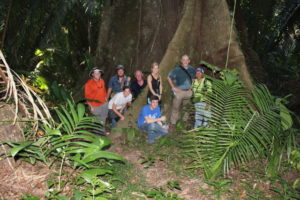NEWS
Top 5 – Trees
Note: During the COVID-19 pandemic, we have the chance to learn a little more about our Louisiana Tech University Family: students, staff, alumni, faculty, and friends. We’ll call it Tech Top 5. Go to LATechSports.com for more Top 5s. #TogetherApart
Dr. Gordon Holley
 Award-winning educator Dr. Gordon Holley, professor in Louisiana Tech’s Agricultural Sciences and Forestry Department, is a tree guy. Bigtime. When he joined the Tech staff in 2005, he helped redesign the forestry school’s summer camp in response to student’s expressed need to have a greater proportion of instruction in the field and created an annual, two-week spring trip to Honduras for Tech forestry students. The Tech Honduras program ended in 2012, but that same year Holley started leading his church’s annual mission trips there. “I guess it should come as no surprise,” he said, “that two of my favorite trees come from central America.”
Award-winning educator Dr. Gordon Holley, professor in Louisiana Tech’s Agricultural Sciences and Forestry Department, is a tree guy. Bigtime. When he joined the Tech staff in 2005, he helped redesign the forestry school’s summer camp in response to student’s expressed need to have a greater proportion of instruction in the field and created an annual, two-week spring trip to Honduras for Tech forestry students. The Tech Honduras program ended in 2012, but that same year Holley started leading his church’s annual mission trips there. “I guess it should come as no surprise,” he said, “that two of my favorite trees come from central America.”
- Loblolly Pine (Pinus taeda): Loblolly is the king of the forests in Louisiana. It is the chief economic driver in the state, contributing the majority of the $850+ billion of Louisiana’s forest products industry. Loblolly pine trees can grow 150 feet tall with diameters of almost 60 inches and live for up to 300 years. Loblolly pine lumber (and other products such as plywood, oriented strand board, etc.) is used extensively to build houses all over the country and supplies many other products such a paper and cardboard.
- White Oak (Quercus alba): The white oak is a large, strong, and beautiful tree that ranges throughout much of the southern, mid-western, and northern states. White oaks are slow-growing trees that can reach 150 feet tall and four feet in diameter after 600 years. In the fall leaves can range from brown to a brilliant reddish–orange color. Of course the best feature of white oak is its strong, heavy, durable, and rot-resistant wood, which makes beautiful furniture, parts of many musical instruments, and best of all, is used in “tight” cooperage to age beer, wine, bourbon, and other spirits.
- Ceiba (Ceiba pentandra): Known commonly as la ceiba in Spanish or Yax Che in the Chorti Maya language of southern Mexico and northern Central America. The ceiba is an impressive tree that grows to more than 200 feet tall and 10 feet in diameter. When young, the trunk is covered with sharp spines, and mature trees have a wide-finned base followed by clear, straight stems extending upwards to more than 100 feet before breaking into a thick round crown. The ceiba was a culturally important tree to the ancient Maya people, who believed it to connect to the three worlds: the roots in the underworld, the trunk in the “people” world, and its crown dwelled with the gods in the heavens.
- Cacao tree (Theobroma cacoa): While not a tall tree—they reach 25 feet at most—cacao are still impressive trees. They thrive in warm, shaded conditions in areas that receive an average of 70 inches of rain a year and actually require a minimum of four inches of rain per month. One of the many interesting features of the cacao tree is that it exhibits “cauliflory” fruiting, meaning that the trees flower and fruit from their woody main stems or branches rather than from new shoots. When ripe, the fruiting bodies, or pods, can range from bright red, yellow, purple, and orange. Each tree can have a mixture of all these colors. Most importantly, the scientific name (Theobroma) comes from the Greek words “theos,” meaning god, and “broma,” meaning food—in other words, “the food of the gods.” This is important because inside the pods are coco beans, the basis for chocolate!
- Texas Live Oak (Quercus fusiformis): When I was a child growing up in Central Texas, these stately oaks were everywhere and to me, there was no better “climb’n” tree. Although rather short in stature, the squatty tree is often wider than it is tall with its huge crooked branches dipping and flowing and often resting on the ground, looking like they are holding the tree upright. The trees are adapted to the hot dry summers of central Texas and can live as many as 1,000 years. One of the most famous Texas live oaks almost had its life cut short in 1989 when it was around only 500 years old. Treaty Oak, famed for being the last remaining tree of a small grove of trees under which Stephen F. Austin, known as the father of Texas, and the Comanche and Tonkawa Indians negotiated the first boundary treaty that allowed settlements in what is now Austin, Texas. In 1989, a disturbed man poisoned the tree in a bizarre witchcraft ritual to symbolize his love for his methadone counselor. Despite massive efforts to save it, only about one-third of the tree remains alive today. In my office I have a small “cookie” from one its branches.
Recent Comments